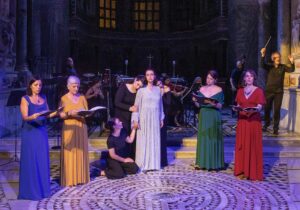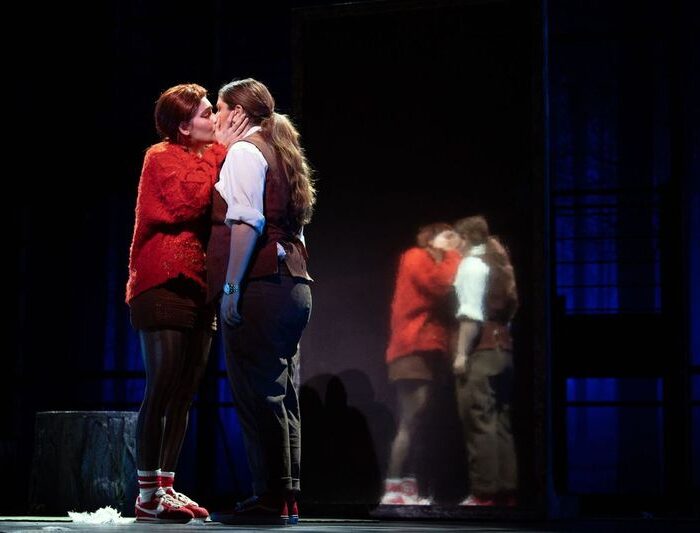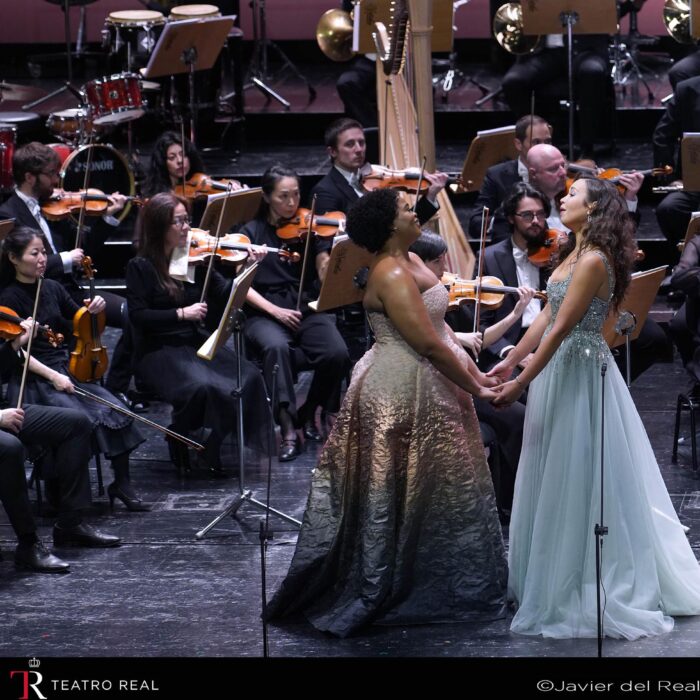
Ravenna Festival 2023 Review: Stabant Matres
Marzocchi’s Spiritual Parable Receives Splendid Premiere In The Stunning San Vitale Basilica
By Alan NeilsonPhoto credit: Zani-Casadio
The Ravenna Festival does not want for quality venues. In fact, it is able to boast access to some of the most stunning venues in Europe including the Byzantine masterpiece, the San Vitale Basilica, which dates back as far as the 6th century AD. Its visually stunning mosaic frescoes cover the walls and ceiling of the alter and are dominated by the Emperor Justinian and the Empress Theodora. They cannot fail to impress. The basilica has an octagonal design on two levels and is supported by large, thick pillars with a high central dome. This was decorated in the baroque style during the 18th century.
However, what makes it a particularly pleasing space for performances of works with a vocal component is its fascinating acoustics. One can hear the voices echoing in the angles of the building or traveling upwards into the dome where they seem to linger. Its large pillars create wonderful effects as the sounds disappear, reemerge and combine. Certainly, any composer sympathetic to its unique qualities is almost certain to captivate the audience. Paolo Marzocchi, with his newly commissioned work “Stabant Matres,” did not disappoint.
A Religious Parable
Together with the librettist Guido Barbieri, Marzocchi embraced the basilica’s history and purpose to create an unambiguously religious work based on Christ’s genealogy and taken from the opening chapter of St. Matthew’s gospel. Defined as a “spiritual parable” for five soloists, three actresses, a mixed chorus and an instrumental ensemble, the piece was sensitively constructed to work in harmony with the space. It both enhanced and was enhanced by the building’s centuries-old architecture as well as the iconography contained within the painted dome and its colorful mosaics.
St. Matthew recounts Christ’s ancestry through the male line and mentions only five of the women who bore the sons. The majority of Christ’s female ancestors are not named. But, it is about the significance of these women, including Tamar, Rahab, Rut, Betsabea and of course, Maria, that drew Marzocchi and Barbieri’s attention. Apart from Maria, all the women come from outside the “chosen people.” They are not Jewish, nor are they all of noble birth or of high moral standing. In fact, it is likely that Rahab was a prostitute, while Betsabea was certainly an adulteress. Thus, Jesus is not racially pure but is descended from other peoples. He is not of pure royal blood, although the blood of David and of Abraham does run through his veins. Christ is, therefore, a product and belongs to all Mankind. As Barbieri writes in his program notes, “Christ will be the son of the ‘chosen people’ but he will also be a gift made to all humanity without distinction of wealth, belonging or identity.”
The piece is imaginatively structured. It opens with the choir creating the sound of sharp exhalations of breath that slowly crystallize into syllables and then into the words of the Holy Spirit to enunciate Christ’s lineage. This is followed by three circles. In the first, each of the four “foreign” women sing a closed aria in which they introduce themselves. In the second circle, the women come together to form a quartet, in which they explain how they each found themselves in Israel. In the third circle, they are joined by Maria, who acknowledges that they are sisters in childbirth. Jesus belongs to all of them. The parable is brought to a close by the single soprano voice from the choir intoning “Ave Maria, o auctrix vitae.”
Throughout the performance, the chorus sings in Hebrew. They detail each of the women’s positions in Jesus’s ancestry before finally taking on the role of all women who are pleading for the people not to harm their son.
The three actresses were used as a representation of the Trinity. They speak together with a single voice or individually. Towards the end of the third cycle, as Mary sings of her suffering, the three embrace her. She is in the arms of God, in all his forms.
A Composition Sensitive To The Unique Acoustics
Marzocchi clearly took his time considering not just the dramatic impact, but also the acoustic effects when deciding where to position the various musical elements. He makes use of the entire space by situating the choir in two parts in the upper tier, separated by a single trumpet player, at the opposite end of the church to the altar where he had positioned the instrumental ensemble. This gave the musical performance a spatial dimension, which one rarely hears with such clarity. The sounds of the choir flooded the basilica from the rear, while the sound of the ensemble exited the alter into the body of the church. The two waves of sound enveloped the seated audience with stunning effects. Simultaneously, the sound of the voices spiraled upwards into the dome, where it hovered and pulled one’s gaze towards its painted frescoes. All of this magnified the religious experience and reinforced the message of the parable.
Marzocchi’s choice of individual and combinations of instruments was also expertly designed to create a variety of appealing and captivating effects. The solo trumpet filled the space with its strong presence, but was always drawn towards the dome. The sound of the percussion, on occasions, appeared determined to explore the whole basilica. Its sound echoed gently in its alcoves and corners. The solo flute also had a mesmerizing effect in which its sound seemed suspended and almost outside real space. It was as if it were from heaven itself. More than any other aspect of the work, it was Marzocchi’s orchestration and his ability to use it. He impressively expoited the unique acoustics of the basilica.
The La Corelli Ensemble, under Marzocchi’s own direction, provided able support with a clear, animated and detailed performance that was attentive to the dramatic and atmospheric nuances of the work. Their ability to suggest the heavenly and earthly dimensions was sensitively wrought. The musicians were frequently required to provide individual contributions, either to accompany singers or for solo passages, which were always skillfully played.
Five Pleasing Female Roles
During the first circle, the four “foreign” women stood apart from each other. They were positioned in between the audience members on the ground floor. Each made a good impression with their individual arias.
Manuela Rasori, essaying the role of Tamar, has a pleasing, clear and at times, piercing soprano with a strong resonance. She successfully filled the basilica, although occasionally she displayed a weakness in holding the line.
Soprano Clara La Licata produced a vocally strident and forceful performance with an expressivity in the role of Betsabea. Her clear articulation, vocal flexibility and pleasing tone impressed.
Apart from a little too much vibrato, mezzo-soprano Simona Mastropasqua put on a good performance as Rahab. Her colorful palette and bright high notes enlivened the aria’s simple melody.
Soprano Benedetta Gaggioli, accompanied by the soft sounds of the flute, showed off the beauty of her voice with a sensitive and assured performance. Standing directly below the dome, her voice carried gracefully upwards into the dome, where the purity of her bright and clear-toned high notes were magnified to good effect.
When the four came together as a group in the second circle, the voices combined smoothly to create a pleasing balance, although with sufficient contrast to create interest.
It was not until towards the end of the second circle that Maria, played by Valentina Coladonato, appeared. Entering the performance area from the side, she made an immediate impact with her resonant, full-bodied voice. Her singing was expansive and confident. She expertly crafted her lines to bring out their emotional depth. She displayed a fine degree of vocal versatility, notably so in a series of slow, poignant and easy-lying passages of coloratura.
All the singers wore formal dresses in a different color from each other. Yellow for Tamar, green for Betsabea, red for Rahab and blue for Rut, with Maria in white. Although they were not intended to be costumes, the distinct colors created a strong and positive visual impression.
The Coro Ecce Novum, directed by chorus master Silvia Biasini, produced a sensitive and engaging performance that was fundamental in creating the religious aura that defines the work.
The actresses, situated to the right of the ensemble, were miked. Normally this would not be ideal, but on this occasion it gave the voices a hollow effect that suggested an ethereal dimension. The three actresses were from the Scuola di Teatro di Bologna “Alessandra Galante Garrone.” However, for reasons unknown, they were not named in the program. All produced clearly articulated and animated performances. They possessed a distinctive vocal quality that allowed for pleasing contrasts.
Lasting just over one hour, “Stabant Matres” is a fine work that deserves to be heard again. However, Marzocchi clearly wrote the work for the San Vitale Basilica’s unique acoustics and ambience. Whether or not it could be successfully presented in another location remains to be seen.



